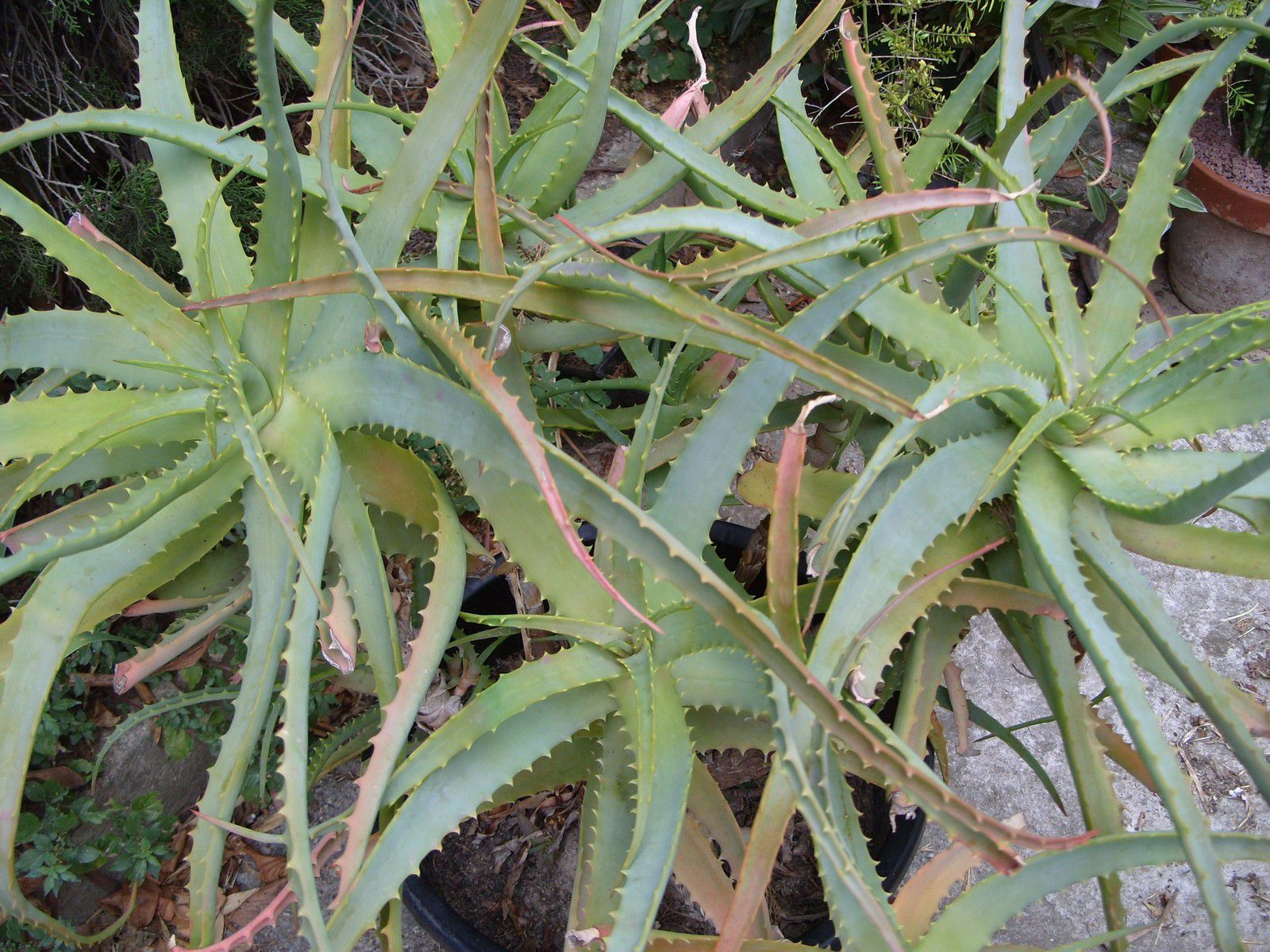Famille des Asphodelaceae
Genre: Aloe Linné 1753
Nom scientifique: Aloe arborescens
Miller 1768
Distribution: Sud de l'Afrique.
Etymologie: origine incertaine, de l'Arabe "alloch" = amère ou "alloeh", du Grec "aloe" ou de l'Hébreu "ahalim ou allal" = amère;
arborescens, du Latin "arbor" = arbre.
Synonymes: Aloe fructicosa, Aloe arborea, Catevala arborescens.
Température de rusticité: - 3°C si bref et tenu au sec.
Exposition: plein soleil.
Culture: nécessite un substrat drainant. Arroser de Mars à Octobre puis diminuer les arrosages en hiver (une fois par mois par beau temps). Peut être planté à l'extérieur dans le sud de la France dans un sol bien drainant. Nombreux rejets à la base qui se forment et que l'on peut bouturer facilement.


-----------------------------------------------------
Données supplémentaires
1) Aloe arborescens Mill.
A dense, shrubby aloe, 2-3 tall; it is the most widely distributed of its genus in South Africa, extending along the mountain ranges (but also down to sea level) from Riviersonderend in the Western Cape to Mpumalanga and Limpopo Provinces, a range of more than 1600 km in South Africa alone; it occurs in Mozambique and eastern Zimbabwe, extending westwards to the Victoria Falls; in Malawi it grows at the top of Dedza Montain. It is common in cultivation, sometimes forming impenetrable hedges. The common form has scarlet flowers on a simple, conical or elongated-conical raceme, but there is a less vigorous form with yellow flowers. Flowering from May to June. A third form with a single stem of 1-2 m is reported to occur on Mount Mulanje in Malawi. Subsp. mzimnyati (Vaan Jaarsveld & Van Wyk 2005) is a smaller form with shorter perianth, growing on quartzitic sanstone cliffs along the lower Mzinyathi (Buffels) River near its confluence with the Tugela in KwaZulu-Natal. Dwarf form of this species crowded onto cracks in rocky terrain have been seen on the slopes of the southern Langeberg near Robertson in the Western cape.
Référence: Doreen Court, dans "Succulent Flora of Southern Africa", Revised Edition, Struik Nature Edition, p 240, 2010.
2) Aloe arborescens
Miller, Gard. Dict. ed. 8: no. 3 (1768)
Plant much branched, with stems to 2-3 m high, 30 cm thick at the base, with persistant dead leaves for 30-60 cm. Leaves densely rosulate, triangular, 50-60 x 5-7 cm, dull green to grey-green; margins with firm teeth, 3-5 mm long, usually curved towards the apex, 5-20 mm apart. Inflorescence 60-80 cm tall, usually simple, sometimes with one branch. Racemes conical to elongate-conical, 20-30 x 10-12 cm, densely flowered. Floral bracts ovate-acute to obtuse, 15-20 x 10-12 mm. Pedicels 35-40 mm long. Perianth scarlet, 40 mm long, base rounded, 7 mm across the ovary, slightly, narrowed above, then enlarging towards the mouth; outer tepals free to the base. Stamens and style exserted c. 5mm.
South Africa Eastern Cape, Fort Cunynghame, Galpin 2463 (PRE, GRA). The species was not typified by Miller and no original herbarium material has been traced; hence, Galpin 2463 was designated as neotype (erroneously referred to as holotype) by Glen and Hardy (2000). Widely distributed in Malawi, Mozambique, Zimbabwe and South Africa; typically found on rocky slopes, sometimes in dense bush, from near sea-level up to 2,800 m in altitude.
Référence: S. Carter, J.J. Lavranos, L.E. Newton, C.C Walker, dans "Aloes, The Definitive Guide", Kew Publishing Edition, p 660, 2011.
3)

Référence: Succulentes, N°1, Février 1997.
4)

Photo: J. Lodé
Référence: Cactus Aventures International, N°34, Avril 1997.

/image%2F1217490%2F20211216%2Fob_67e2e1_gymnocalycium-baldianum-9.JPG)


/image%2F1217490%2F20210904%2Fob_80574c_aloe-doran-black-23.JPG)
/image%2F1217490%2F20200209%2Fob_6b6b4c_aloe-melanacantha-2.JPG)
/image%2F1217490%2F20180529%2Fob_48bc3e_img-1476.JPG)
/idata%2F3917426%2FMes-succulentes%2FAloe-somaliensis--4-.JPG)
/image%2F1217490%2F20231001%2Fob_fe4155_epiphyllum-oxypetalum-4.JPG)
/image%2F1217490%2F20231001%2Fob_a20e8e_img-7333.JPG)
/image%2F1217490%2F20231001%2Fob_21283f_kalanchoe-tuniflora-1.JPG)
/image%2F1217490%2F20230121%2Fob_197e7c_blog-parodoa-procera-9.JPG)
/image%2F1217490%2F20230121%2Fob_b113e6_blog-mammillaria-perbella-7.JPG)
/image%2F1217490%2F20230121%2Fob_7e9446_blog-mammillaria-matudae-16.JPG)